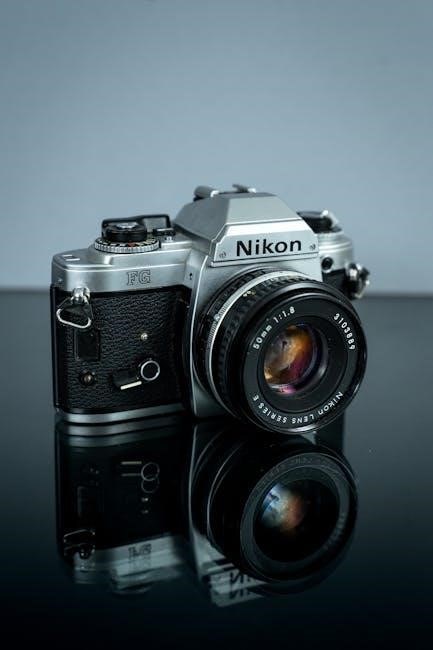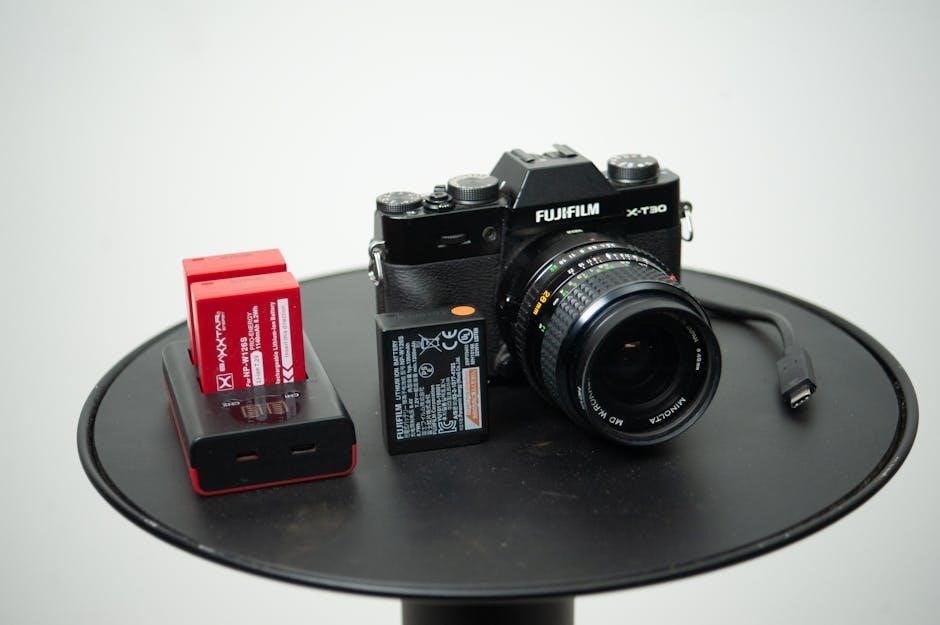Nikon D750 Owners Manual: A Comprehensive Guide
Welcome to the world of the Nikon D750! This guide acts as a detailed roadmap, offering insights beyond the standard user manual. We aim to empower you, whether beginner or seasoned photographer, to unlock the full potential of this powerful camera.
The Nikon D750, released in 2014, is a versatile full-frame (FX-format) digital SLR camera celebrated for its blend of performance and portability. It bridges the gap between professional-grade features and user-friendly operation, making it a favorite among enthusiasts and professionals alike. The D750 boasts a 24.3-megapixel CMOS sensor, delivering stunningly sharp images with impressive dynamic range. Its low-light capabilities are exceptional, thanks to a wide ISO range, expandable up to 51200.
Beyond image quality, the D750 offers a robust autofocus system with 51 focus points, ensuring fast and accurate subject tracking. It can also shoot continuously at 6.5 frames per second, capturing fleeting moments with ease. The camera’s tilting LCD screen provides flexibility for shooting from various angles, while built-in Wi-Fi enables seamless image sharing and remote control.
This manual is designed to guide you through every aspect of the D750, from basic setup to advanced techniques. Whether you’re exploring manual mode for the first time or fine-tuning your autofocus settings, this guide will help you master your D750 and unleash your creative vision. With its wealth of features and customizable options, the D750 is a powerful tool for capturing the world around you.
Understanding the Camera’s Specifications
Delving into the Nikon D750’s specifications reveals its impressive capabilities. At its heart lies a 24.3MP FX-format CMOS sensor, capable of producing images with a maximum resolution of 6016 x 4016 pixels. This sensor size contributes to excellent low-light performance and shallow depth-of-field effects. The ISO sensitivity ranges from 100 to 12800, expandable to 50-51200, providing flexibility in various lighting conditions.
The D750’s autofocus system features 51 focus points, including 15 cross-type sensors for enhanced accuracy. It offers continuous shooting at up to 6.5 frames per second, suitable for capturing action sequences. The camera records Full HD 1080p videos at up to 60fps, with manual control over audio levels.
Other key specifications include a 3.2-inch tilting LCD screen with 1,229k-dot resolution, built-in Wi-Fi for wireless connectivity, and dual SD card slots for storage flexibility. The D750 uses the EN-EL15 battery, providing ample power for extended shooting sessions. Understanding these specifications is crucial for maximizing the D750’s potential and tailoring it to your specific photographic needs. Knowing the camera’s capabilities allows for informed decisions when shooting.
Navigating the User Interface
The Nikon D750’s user interface is designed for intuitive control and efficient operation. The mode dial, located on the top left, provides quick access to various shooting modes, including Manual (M), Aperture Priority (A), Shutter Priority (S), and Program (P). The command dials, front and rear, allow for adjusting aperture and shutter speed in manual and semi-automatic modes.
The camera’s menu system is organized into logical sections, such as Shooting Menu, Custom Setting Menu, Setup Menu, Retouch Menu, and My Menu. These menus provide extensive customization options, allowing you to tailor the camera’s behavior to your preferences. The ‘i’ button offers a shortcut to frequently used settings, enabling quick adjustments without navigating through the main menu.
The D750’s LCD screen displays essential shooting information, including aperture, shutter speed, ISO, and exposure compensation. The virtual horizon feature helps ensure level shots, while the highlight display prevents blown-out highlights. Learning the layout of the buttons, dials, and menus is key to mastering the D750. Practice navigating the interface to become more efficient and confident in using the camera’s features. Familiarity with the user interface will allow you to react quickly.
Downloading the PDF User Manual
Accessing the official Nikon D750 user manual in PDF format is a crucial step for understanding your camera’s capabilities. The PDF manual is a comprehensive resource, offering detailed explanations of every feature, setting, and function. To download it, visit the official Nikon website and navigate to the support section.
Search for the D750 model and locate the ‘Downloads’ tab. Here, you’ll find the user manual available for download. Ensure you download the correct language version. The PDF manual allows for offline access, making it convenient to consult even without an internet connection. You can save it on your computer, tablet, or smartphone for easy reference.
The PDF format enables easy searching for specific topics, using keywords. This is particularly helpful when troubleshooting issues or learning about a particular function. Keep the manual readily available. Regularly refer to it as you explore the camera’s features. It serves as an invaluable tool for maximizing your D750’s potential. Some third-party websites may also offer the manual, but downloading from Nikon’s official site ensures you get the most accurate and up-to-date version. Take full advantage of the PDF manual to master the Nikon D750!
Nikon Manual Viewer 2 App
The Nikon Manual Viewer 2 app is a fantastic resource for D750 owners, offering convenient access to the camera’s user manual on your smartphone or tablet. This app eliminates the need to carry around a physical manual or rely solely on a PDF version on your computer. Available for both iOS (iPhone, iPad, iPod touch) and Android devices, the app can be downloaded for free from the App Store or Google Play.
Once installed, you can download the D750 manual directly to your device for offline viewing. This is particularly useful when you’re out in the field and don’t have internet access. The app provides a user-friendly interface, making it easy to navigate through the manual and find the information you need. You can search for specific topics, bookmark important pages, and even annotate the manual with your own notes.

The Nikon Manual Viewer 2 ensures that you always have the information you need at your fingertips. It’s an excellent way to familiarize yourself with the D750’s features and troubleshoot any issues you may encounter. By having the manual readily available on your mobile device, you can quickly learn and improve your photography skills while on the go. Download the app today and take full advantage of this valuable tool!
Essential Settings for Beginners
Embarking on your Nikon D750 journey can be exciting, but understanding the initial settings is crucial for capturing great images. Let’s explore some essential settings for beginners to get you started. Firstly, setting the image quality to “JPEG Fine” or “RAW” ensures you’re capturing high-quality images with ample detail. Next, choose the appropriate white balance setting based on your shooting environment – “Auto” generally works well, but experiment with presets like “Daylight” or “Cloudy” for specific scenarios.
Set the ISO to “Auto ISO” initially, allowing the camera to automatically adjust sensitivity based on lighting conditions. As you gain experience, you can manually control ISO for creative effects. For focusing, start with “AF-S” (Single-servo AF) for stationary subjects and “AF-C” (Continuous-servo AF) for moving subjects. Select a focus point that aligns with your subject for sharp results. Metering mode is another important setting. “Matrix” metering is a good starting point, as it evaluates the entire scene to determine exposure.
Finally, familiarize yourself with the camera’s exposure compensation dial. This allows you to fine-tune the brightness of your images. These initial settings provide a solid foundation for learning the Nikon D750. As you become more comfortable, feel free to explore other settings and discover your own creative style.
Auto and Manual Focus Modes

The Nikon D750 offers a versatile range of focusing options, allowing you to capture sharp images in various shooting scenarios. Understanding both auto and manual focus modes is essential for maximizing your creative control. Auto focus (AF) modes provide convenience and speed, while manual focus (MF) offers precision and flexibility. Let’s delve into the key AF modes: AF-S (Single-servo AF) is ideal for stationary subjects, locking focus once and remaining fixed. AF-C (Continuous-servo AF) is designed for moving subjects, continuously adjusting focus as the subject moves.
For AF-area mode, Single-point AF allows you to select a specific focus point, while Dynamic-area AF uses surrounding focus points to track moving subjects. 3D-tracking AF intelligently tracks subjects as they move across the frame. Auto-area AF automatically selects focus points, which can be useful for quick snapshots but may not always prioritize your desired subject. Manual focus (MF) provides complete control over the focusing process. Use the focusing ring on your lens to adjust focus manually, relying on your eyesight and the camera’s focus confirmation indicators.
MF is particularly useful in situations where AF struggles, such as low light or when shooting through obstructions. Mastering both auto and manual focus modes empowers you to adapt to diverse shooting conditions and achieve your desired results with the Nikon D750. Experiment with different modes to discover what works best for you.
Exploring Manual Mode
Manual mode (M) on the Nikon D750 offers unparalleled creative control over your photography. Unlike automatic modes, manual mode puts you in charge of both aperture and shutter speed, allowing you to precisely control the exposure and depth of field in your images. To engage manual mode, simply set the mode dial on the top of your D750 to “M.” In manual mode, you adjust the aperture using the main command dial, which controls the size of the lens opening. A wider aperture (smaller f-number like f/2.8) lets in more light, creating a shallow depth of field and blurred backgrounds.
A narrower aperture (larger f-number like f/16) lets in less light, resulting in a greater depth of field and sharper images from foreground to background. Adjust the shutter speed using the sub-command dial, which determines how long the camera’s sensor is exposed to light. A faster shutter speed (like 1/1000 second) freezes motion, while a slower shutter speed (like 1 second) allows for motion blur and capturing more light in dark environments. The D750’s built-in light meter helps you achieve proper exposure by indicating whether your settings will result in an overexposed or underexposed image.
Adjust the aperture and shutter speed until the meter reads “0” for a balanced exposure. Experimentation is key to mastering manual mode. Take the time to practice adjusting aperture and shutter speed in different lighting conditions to see how they affect your images. With patience and practice, you’ll unlock the full creative potential of your Nikon D750.
Troubleshooting Common Issues
Even with a robust camera like the Nikon D750, users may occasionally encounter issues. One frequent concern is blurry images. Ensure your shutter speed is fast enough to prevent motion blur, especially in low light or when shooting moving subjects. Also, confirm that your focus mode is appropriate for the scene; for stationary subjects, use single-point AF, while for moving subjects, continuous AF is ideal.
Another common problem is underexposed or overexposed photos. Check your camera’s light meter reading and adjust aperture, shutter speed, or ISO accordingly. If the meter isn’t responding accurately, reset the camera to its default settings.
Battery drain can also be a concern. Ensure your battery is fully charged and consider carrying a spare. Disable features like Wi-Fi and GPS when not in use, as they consume significant power. If your D750 freezes or becomes unresponsive, try removing and reinserting the battery to reset it. Error messages can be perplexing, but they often provide clues to the problem. Consult the user manual for specific error codes and their corresponding solutions.
If you’re still facing issues, consider checking online forums or contacting Nikon support for assistance. Remember to keep your camera’s firmware updated to benefit from bug fixes and performance improvements. With a systematic approach, most common issues can be resolved, ensuring a smooth and enjoyable shooting experience with your Nikon D750.
Firmware Updates and Downloads
Keeping your Nikon D750’s firmware updated is crucial for optimal performance and access to the latest features. Firmware updates often include bug fixes, improved compatibility with accessories, and enhancements to image processing algorithms. To check your camera’s current firmware version, navigate to the setup menu and select “Firmware Version.”
Before initiating an update, ensure your battery is fully charged to prevent interruptions during the process. Download the latest firmware version from the official Nikon website. Locate the D750 firmware section and carefully read the instructions provided.
Typically, you’ll need to download the firmware file to your computer and then copy it to a formatted SD card. Insert the SD card into your D750 and access the firmware update option in the setup menu. Follow the on-screen prompts to install the update.
It’s essential to avoid powering off the camera or removing the SD card during the update process, as this can cause serious damage. Once the update is complete, verify that the new firmware version is correctly installed. Nikon also provides various software downloads, such as Nikon ViewNX-i and Capture NX-D, which offer tools for image editing, organization, and RAW processing. Regularly checking for and installing these updates ensures you get the most out of your D750.
Available Accessories and Compatibility
The Nikon D750 boasts broad compatibility with a range of accessories, enhancing its versatility and catering to diverse photographic needs. Lenses are paramount, and the D750, with its FX-format sensor, supports both FX and DX lenses. While FX lenses provide the full-frame field of view, DX lenses can also be used, albeit with a crop factor.
External flashes, like Nikon’s Speedlight series, offer enhanced lighting control, enabling creative lighting techniques and improved low-light performance. Remote controls and intervalometers facilitate remote shooting, time-lapses, and bulb exposures, expanding creative possibilities.
For extended shooting sessions, consider a battery grip, which accommodates additional batteries and often provides a more comfortable grip, especially for portrait orientation shooting. Microphones are essential for video recording, and the D750 is compatible with external microphones, delivering superior audio quality compared to the built-in microphone.
The D750 also supports various memory cards, including SD, SDHC, and SDXC cards, offering ample storage for high-resolution images and videos. Additionally, the camera is compatible with Nikon’s software suite, enabling seamless image transfer, editing, and management. Exploring these accessories can significantly enhance your D750 experience and unlock new creative avenues. Be sure to check compatibility before purchasing any accessory.
Used Camera Gear Options
Third-Party Guides and Resources
Beyond the official Nikon D750 owner’s manual, a wealth of third-party guides and resources exists to deepen your understanding and mastery of this camera. These resources often provide alternative perspectives, practical tips, and in-depth explanations that complement the manufacturer’s documentation.
Books, such as “Mastering the Nikon D750” by Darrell Young and “Thom Hogan’s Complete Guide to the Nikon D750,” offer comprehensive coverage of the camera’s features and functions, along with real-world shooting advice. These guides often delve into specific shooting scenarios and provide detailed settings recommendations.
Online forums and communities dedicated to Nikon cameras, such as Nikonians and DPReview, provide platforms for users to share their experiences, ask questions, and receive advice from fellow photographers. Websites like CreativeLive offer video tutorials and workshops covering various aspects of Nikon D750 photography, from basic settings to advanced techniques.
Furthermore, many photography blogs and websites feature articles, reviews, and tutorials specifically tailored to the D750. These resources can be invaluable for staying up-to-date on the latest firmware updates, discovering new accessories, and learning about creative shooting techniques. Exploring these third-party guides and resources can significantly enhance your learning journey and help you unlock the full potential of your Nikon D750.
